In introducing the puzzle-loving logician Raymond Smullyan, the chairman of a meeting praised him as unique.
“I’m sorry to interrupt you, sir,” said Smullyan, “but I happen to be the only one in the entire universe who is not unique.”
In introducing the puzzle-loving logician Raymond Smullyan, the chairman of a meeting praised him as unique.
“I’m sorry to interrupt you, sir,” said Smullyan, “but I happen to be the only one in the entire universe who is not unique.”
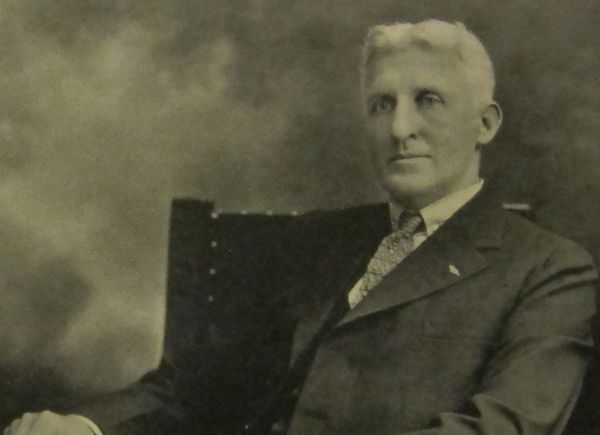
In 1919, Ohio businessman Arthur Nash decided to run his clothing factory according to the Golden Rule and treat his workers the way he’d want to be treated himself. In this week’s episode of the Futility Closet podcast we’ll visit Nash’s “Golden Rule Factory” and learn the results of his innovative social experiment.
We’ll also marvel at metabolism and puzzle over the secrets of Chicago pickpockets.

In 1982, MIT physicist A.P. French received this letter from a writer in New Rochelle, N.Y.:
Being a safety minded individual I thought I would write you before experimenting on my own. Is it safe to mix Antipasto and Pasta together and could this be a future energy supply?
He responded:
I believe that your thoughtful and interesting suggestion about the mixing of pasta and antipasto deserves some acknowledgment. This process might well be a significant energy source — but only, I think, intragastrically. I estimate that the digestion of 1 lb of the mixture would release energy equivalent to about 0.001 megawatt hours or 0.000001 kilotons of TNT. I would not foresee any unusual hazards.
(From Robert L. Weber, ed., Science With a Smile, 1992.)
In a 2013 study of tongue twisters, MIT psychologist Stefanie Shattuck-Hufnagel found that some volunteers who tried to say this phrase stopped talking altogether:
pad kid poured curd pulled cod
“If anyone can say this ten times quickly, they get a prize,” she said.
Another, from my notes:
She (to workman finishing bottom of flying boat hull) — Are you copper-bottoming ’em, my man?
He — No; I’m aluminuming ’em, mum.
— Aerial Age Weekly, Oct. 4, 1915
Artist Jason Shulman has an interesting exhibit this month at London’s Cob Gallery: Photographs of Films condenses the entirety of a given film into a single exposure.
“There are roughly 130,000 frames in a 90-minute film, and every frame of each film is recorded in these photographs,” Shulman says. “You could take all these frames and shuffle them like a deck of cards, and no matter the shuffle, you would end up with the same image I have arrived at. Each of these photographs is the genetic code of a film — its visual DNA.”
Some examples:
Le Voyage dans la Lune (1902):
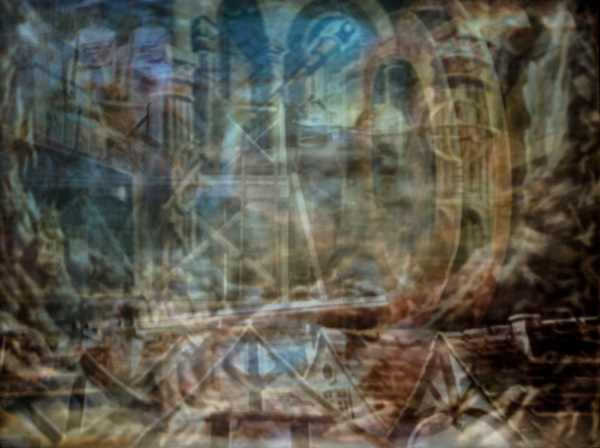
The Wizard of Oz (1939):

Citizen Kane (1941):
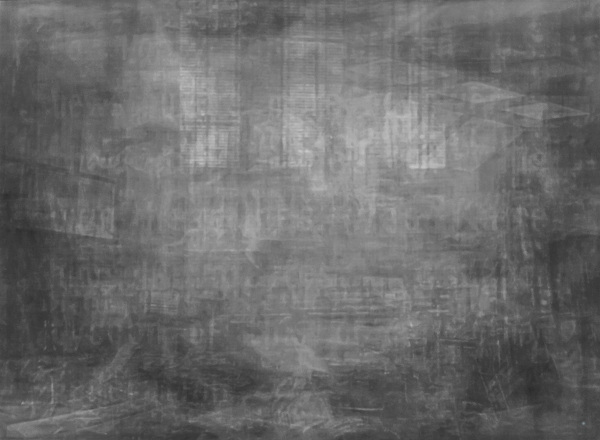
Rear Window (1954):

2001: A Space Odyssey (1968):

The Shining (1980):
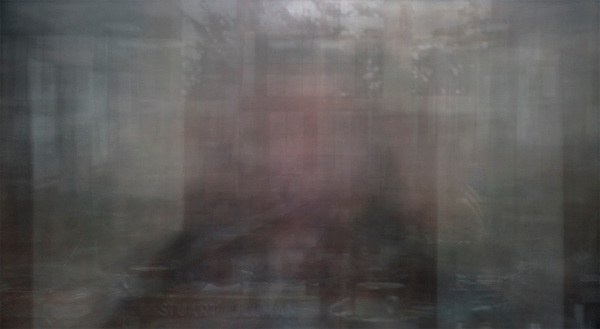
More at Shulman’s site. Japanese artist Hiroshi Sugimoto was conducting similar experiments about 20 years ago, and Kevin L. Ferguson has assembled an impressive collection of his own.

In short, if all the matter in the universe except the nematodes were swept away, our world would still be dimly recognizable, and if, as disembodied spirits, we could then investigate it, we should find its mountains, hills, vales, rivers, lakes, and oceans represented by a film of nematodes. The location of towns would be decipherable, since for every massing of human beings there would be a corresponding massing of certain nematodes. Trees would still stand in ghostly rows representing our streets and highways. The location of the various plants and animals would still be decipherable, and, had we sufficient knowledge, in many cases even their species could be determined by an examination of their erstwhile nematode parasites.
— Nathan Cobb, “Nematodes and Their Relationships,” Yearbook United States Department of Agriculture, 1914
(Thanks, Mick.)

Four straight roads cross a plain. No two are parallel, and no three meet in a point. On each road is a traveler who moves at some constant speed. If Blue and Red meet each other at their crossroad, and each of them meets Yellow and Green at their respective crossroads, will Yellow and Green necessarily meet at their own crossroad?
Suprisingly, the answer is yes. Rob Fatland offers a beautiful solution at the CTK Exchange:
Imagine the whole scenario unfolding from Blue’s rest frame; that is, regard Blue as unmoving and consider the movements of the other travelers relative to him. What does he see? Objectively we know that each traveler moves along a straight line at a constant speed, eventually encounters Blue, and moves on, so from Blue’s perspective each of them moves directly toward him on a straight line, passes through his position, and continues.
Very well, let Red do that. But we know that Red also encounters Yellow and Green without deviating from his own path. And we know that (from Blue’s perspective) Yellow and Green are also traveling straight lines that intersect Blue’s position. This can only mean that Red, Yellow, and Green are all traveling along the same straight line from Blue’s point of view. And this means that Yellow and Green must meet one another.
(It might be objected that two points traveling the same line needn’t meet if they’re going in the same direction at the same speed. But here this would mean that two of the roads are parallel, and that possibility is excluded by the conditions of the problem.)
05/27/2016 UPDATE: Reader Derek Christie recalls a three-dimensional solution: “Make a time axis perpendicular to the plane. Then each traveller moves in a straight line trajectory through this 3D space. Blue and Red meet at a particular place and time, so their two trajectories must meet at a point, and these two trajectories define a plane. Both Yellow and Green trajectories meet the Blue and Red trajectories and so also lie in this same plane. So Yellow and Green must also meet somewhere in that plane.”
Edwin S. Porter’s 1903 feature The Great Train Robbery was distributed with a special segment that the projectionist could insert at the beginning or end of the film. In it, actor George Barnes fires his pistol directly at the audience.
The shot was labeled “REALISM.”
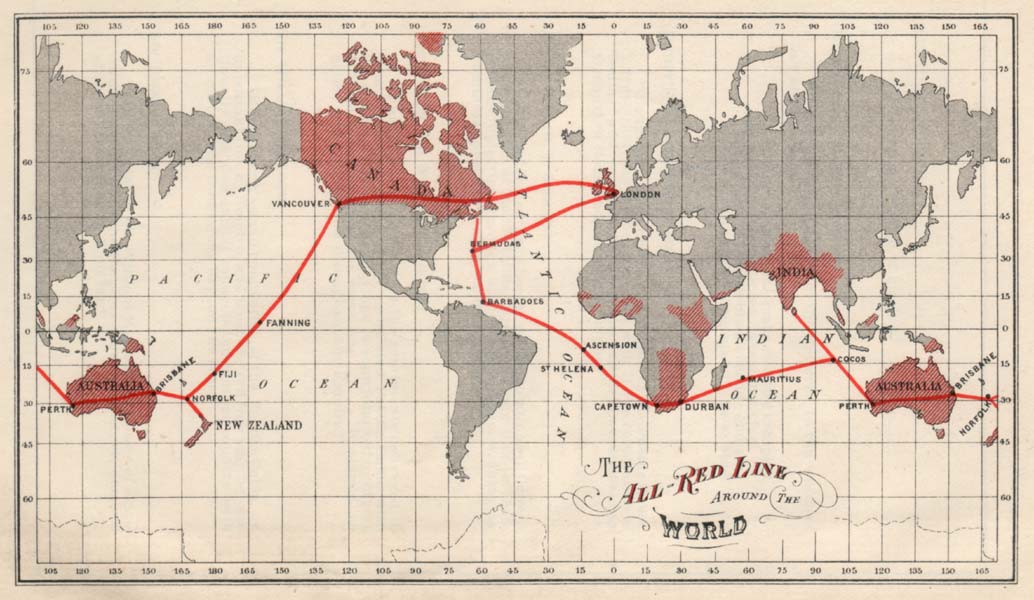
A striking example of the strength of the British Empire in the early 20th century: In 1911 Britain completed the “All Red Line,” a network of telegraphs that linked its possessions. The system was so redundant that an enemy would have had to cut 49 cables to isolate the United Kingdom, 15 to isolate Canada, or 5 to isolate South Africa. As a result, British communications remained uninterrupted throughout World War I.
Sir Sandford Fleming described the network as “the cerebro-spinal axis of our political system … through which would freely pass the sensory impressions and the motor impulses of the British people in every longitude.”
Related: In Air Facts and Problems (1927), Secretary of State for Air Christopher Thomson noted that the whole empire might be visited by an aircraft capable of “long hops”:
For the purposes of the immediate future a ‘long hop’ may be taken as 1,500 miles in length. One such hop would cover the distance from the south coast of England to Malta, a second would reach Egypt, a third Bushire (on the Persian Gulf), a fourth India, at Karachi or Bombay, a fifth Ceylon, a sixth the Straits Settlements, a seventh Port Darwin in Northern Australia; three more would reach New Zealand.
“Thus, in ten ‘long hops,’ or ten days and nights, the traveller and the mailbag out of England would arrive in the most distant of our dominions without landing at an air station which was not either British or under British control.”
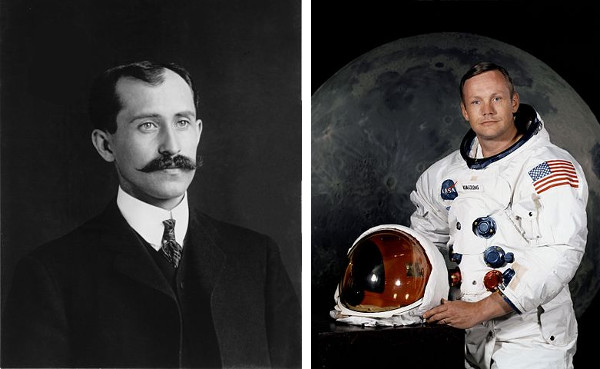
When Orville Wright died, Neil Armstrong was already 17 years old.